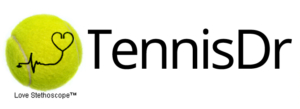Exercise for Your Heart: Determine Your Target Heart Rate (THR) Without Gadgets
Ever wonder how to make tennis your exact cardiovascular workout? How fast should my heart beat during exercise? How long should my workout be and how many times per week? These are great questions and ones that more Americans should ask. This article will provide the basic answers to these questions and you don’t need expensive gizmos and gadgets.
THR is the optimum speed your heart should beat for maximum cardiovascular effect. Too fast and the duration of your exercise session suffers and injury risk rises. Too slow and the cardiovascular system is insufficiently taxed. Staying within a couple beats a minute of THR controls intensity properly.
Many exercise machines and gym posters come with a “zone” for your exercise session, but here are more exact calculations you do for yourself without gadgets. WARNING–it’s important that before starting a new exercise program that you CONSULT A PHYSICIAN. Assuming you are clear to start, there are three main elements to design your cardio workout–Intensity, Duration, and Frequency. Let’s begin with the principle of intensity, which is best controlled at THR.
Intensity of your exercise can be measure by how fast your heart is beating and you don’t need an expensive heart rate monitor of fancy wristwatch, just two fingers. There is a good chance that some time in your life you will need to find out if someone’s heart is beating, so this is a useful skill to practice on yourself. To find your heart rate, gently push two fingers into the soft area to the side of your windpipe or on the palm side of your other wrist below your thumb.
Press lightly until you feel the blood pulsing beneath your fingers or adjust your position until you do. Count the number of beats in 10 seconds and multiply by 6 to get your pulse or beats per minute. Taking your pulse before you get out of bed is called Resting Heart Rate (RHR). Knowing your minimum and maximum pulse is essential to finding your Target Heart Rate (THR) during exercise.
Calculate your Maximum Heart Rate (MHR), the fastest your heart can physically beat, by simply subtracting your age from 220. CAUTION–YOU SHOULD NEVER INTENTIONALLY EXERCISE AT THIS HEART RATE. Now that you know your resting (RHR) and maximum (MHR), you now know the range your heart can beat or Heart Rate Range (HRR) by simply subtracting the slowest (RHR) from the maximum (MHR) your heart can beat. Now you are ready to find your personal and accurate THR.
Sedentary individuals, those that do not exercise regularly, should begin an exercise program at 60% of their range. So, THR = (HRR x 0.6) + RHR. Active individuals, those that regularly exercise at least 3 times a week, should exercise at 65% of their range. For them, THR = (HRR x 0.65) + RHR. Elite athletes, or those with a background of endurance training, can exercise at 70-75% of HRR. Now for duration and frequency.
The duration of exercise at THR should be at least 20 minutes with 5 minutes of warm-up and 5 minutes of cool down. A good warm-up would include stretching of major muscle groups and gradually ramping up heart rate toward THR with the reverse for cool down.
The frequency of exercise at your THR should be 3-5 times a week for improvement and at least 2 times a week for maintenance of your present level of fitness. IMPORTANT–research shows that even lower intensity exercise can still have significant beneficial effects like longer lifespan, enhanced mood, and decreased risk of cardiovascular disease. Controlling the intensity, duration, and frequency of exercise is the key to getting the quickest and most profound benefit.
Regular exercise and cardiovascular fitness have been shown to help prevent degenerative diseases like stroke, diabetes, osteoporosis, and heart disease. It has also proved to help improve allergies, asthma, digestion, stress management, and sleeping disorders.
Interestingly, it is also at least as important to weight control as good nutrition. Plan two or more different ways, or modes, of exercise to promote THR. Whether you choose bicycling, yoga, table tennis, gardening, or even boogie boarding, regular exercise is easier to stick with when it’s fun. Good luck and have fun with your new exercise program!

Leave a Reply
Want to join the discussion?Feel free to contribute!